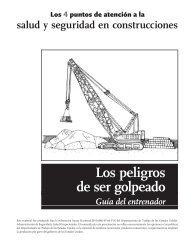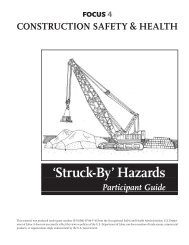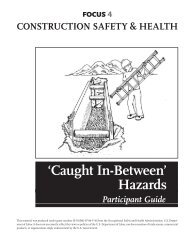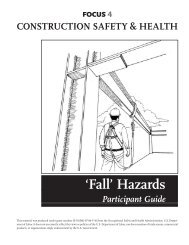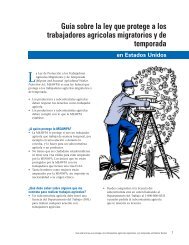Day Labor study 2006.pdf - National Council for Occupational Safety ...
Day Labor study 2006.pdf - National Council for Occupational Safety ...
Day Labor study 2006.pdf - National Council for Occupational Safety ...
Create successful ePaper yourself
Turn your PDF publications into a flip-book with our unique Google optimized e-Paper software.
day labor provides a chance to regain a foothold in the urban economy. For others, it is afirst job in the United States and an opportunity to acquire work experience, skills andemployer contacts. For still others, it represents an opportunity to earn an income whentemporarily laid off from a job elsewhere in the economy. As a result of these and otherfactors, many workers have come to rely on day-labor hiring sites <strong>for</strong> job opportunities.The growth of day-labor hiring sites is also related to changing patterns ofimmigration to the United States, particularly increased immigration flows outside oftraditional port-of-entry cities like New York, Los Angeles and Chicago. New migratorycircuits have developed in the South and parts of the East and Midwest, especially insmall cities and towns with abundant employment opportunities, at least in low-wageoccupations. There has been a dramatic increase in labor migration to these areas, andday-labor hiring sites have become one mechanism <strong>for</strong> organizing the supply ofimmigrant laborers <strong>for</strong> the construction industry and other sectors of the economy.Historically, U.S. employers have relied on immigrant labor to fill jobs in a range ofoccupations, and that demand has not abated. In fact, it has grown as cost pressuresremake the terms of competition in a range of industries, pushing employers to find newstrategies <strong>for</strong> remaining competitive. Industries as diverse as agricultural production,textile manufacturing, child care, restaurants, food processing and construction attempt tocope with cost pressures by hiring undocumented immigrants at low wage rates (seeHum, 2003; Nees, 2005; Sassen, 2005).The proliferation of day-labor hiring sites in the United States has occurred withinthe context of these shifts in labor supply and demand, and signs point to the continuedgrowth of day-labor work. However, like many other lower-wage occupations, day laborhas been characterized by routine violations of workers’ rights. Reports of thenonpayment of wages and workplace safety concerns, among others, suggest that theemergence of day labor is not an entirely benign phenomenon, particularly <strong>for</strong> itswork<strong>for</strong>ce. These issues have attracted attention from the media, policy makers and thegeneral public. But in<strong>for</strong>med public debate on the scope and significance of day labor hasbeen hampered by the lack of accurate in<strong>for</strong>mation about this labor market. This <strong>study</strong>seeks to address this shortcoming.The findings presented in this report are based on the <strong>National</strong> <strong>Day</strong> <strong>Labor</strong> Survey.A random sample of day laborers was drawn from 264 hiring sites in 139 municipalitiesin 20 states and the District of Columbia. A total of 2,660 day laborers were surveyedduring July and August 2004. <strong>Day</strong> laborers were asked a series of questions regardingtheir work experiences, demographic characteristics and issues related to day-labor work.The report is divided into four sections. Section I examines the organization of the daylabormarket, highlighting the size of the market, its geographic distribution and the typesof hiring sites that comprise this labor market. Section II describes the work of daylaborers, including their job assignments, wages and earnings, and working conditions.This section also documents the incidence of workers’ rights abuses and violations ofbasic labor standards that too often accompany day-labor work. Section III presents ademographic profile of the day laborers, including their personal characteristics and work2



